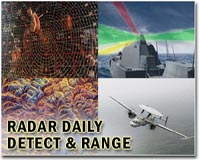 |
Tokyo (UPI) Dec 2, 2010 Japan has requested U.S. approval for an installation contract for radar upgrade kits for its four Boeing E-767 airborne warning and control system aircraft. Japan acquired the four radar systems improvement program kits in 2006, the U.S. Defense Security Cooperation Agency said. "RSIP increases the AWACS aircraft's radar sensitivity, allowing it to detect and track smaller targets," Boeing said. "It also improves the radar's existing computer with a new high-reliability multi-processor and rewrites the software to facilitate future maintenance and enhancements." Boeing delivered the four aircraft to Japan between 1998 and 1999, and they have been in service since 2000. The E-767s are the 767-200 passenger aircraft with an external mounted E-3 AWACS radar dome. Power is from two General Electric CF6-80C2B6FA high-bypass turbofan engines, producing around 61,500 pounds of thrust each. In early 2006, Boeing said it had won a $108 million contract to deliver RSIP kits for Japan's E-767s, with a separate RSIP installation contract to follow. The RSIP increases the AWACS aircraft's radar sensitivity, allowing it to detect and track smaller targets. It also improves the radar's electronic counter-countermeasures, upgrades the existing computer with a new high-reliability multiprocessor and rewrites the software to improve the interface and facilitate future maintenance and enhancements. In May 2006 Japan made the request to the DSCA for the RSIP installation contract to fit the kits. The current request for an installation contract appears to be a follow-on from the original 2006 request. However, the DSCA gave no reason for what appears to be a delay in processing the request. There are no known offset agreements proposed with the sale to Japan. The DSCA said on its Web site that the sale "is vital to the U.S. national interest to assist Japan with developing and maintaining a strong and ready self-defense capability, which will contribute to an acceptable military balance in the region." The sale would be "consistent with U.S. objectives and the 1960 treaty of Mutual Cooperation and Security," the DSCA said. Japan will use Boeing as the prime contractor for the installation, but at a likely cost of around $119 million. The work will include transport of the aircraft to and from Japan, repair of parts, spare parts, support and test equipment, documentation and personnel. The kit is built principally by Northrop Grumman Electronic Systems in Baltimore under a subcontract to Boeing. It consists of a new radar computer, a radar control maintenance panel and software upgrades to the radar and mission system programs. RSIP kits have been installed on the American, British, NATO and French 707-based E-3 AWACS fleets.
Share This Article With Planet Earth
Related Links Space Technology News - Applications and Research
 Radar guns might spot suicide bombers
Radar guns might spot suicide bombersSanta Cruz, Calif. (UPI) Nov 26, 2010 Radar guns used by police to spot speeding motorists could help identify suicide bombers by detecting the wiring in an explosive vest, U.S. researchers say. A police radar gun fires pulses at a car and measures the shift of the reflected signal to calculate its velocity, but the strength and polarization of the reflected signal - the "radar cross section" - can provide additional info ... read more |
|
| The content herein, unless otherwise known to be public domain, are Copyright 1995-2010 - SpaceDaily. AFP and UPI Wire Stories are copyright Agence France-Presse and United Press International. ESA Portal Reports are copyright European Space Agency. All NASA sourced material is public domain. Additional copyrights may apply in whole or part to other bona fide parties. Advertising does not imply endorsement,agreement or approval of any opinions, statements or information provided by SpaceDaily on any Web page published or hosted by SpaceDaily. Privacy Statement |